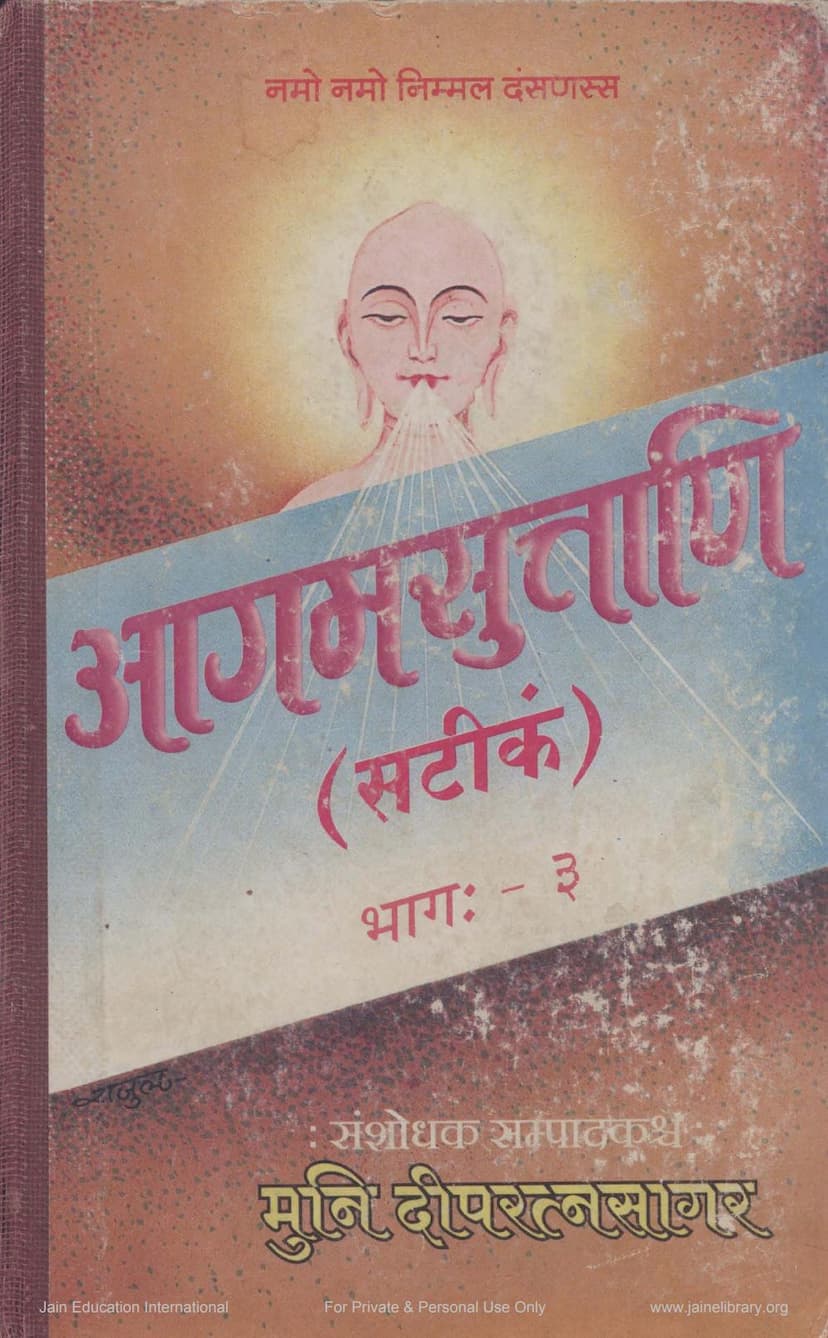Agam Suttani Satikam Part 03 Sthanang
Added to library: September 1, 2025

Summary
This is a summary of the Jain text "Agam Suttani Satikam Part 03 Sthanang," authored by Dipratnasagar and published by Agam Shrut Prakashan. The text is a commentary on the Sthanang Sutra, which is the third Anga of the Jain Agamas.
The provided text is the commentary (Tika) by Acharya Abhaydev Suri on the first section (Sthanang) of the Sthanang Sutra. The book is a comprehensive exposition of the Sthanang Sutra's content, which systematically categorizes Jain philosophical concepts according to numerical groupings, ranging from one to ten.
Key aspects and structure of the text based on the provided pages:
- Title and Authorship: The book is titled "Agam Suttani Satikam Part 03 Sthanang." The authors are Dipratnasagar and Deepratnasagar. The publisher is Agam Shrut Prakashan.
- Commentary: The text specifically mentions the commentary (Vritti) by Acharya Abhaydev Suri.
- Content Organization: The text is meticulously organized, outlining the subjects covered within each of the ten 'Sthanas' (sections) of the Sthanang Sutra. Each Sthana is further broken down into 'Uddeshakas' (sub-sections).
- Scope of Sthanang Sutra: The Sthanang Sutra deals with a wide array of Jain philosophical and practical topics, including:
- The nature of the soul (Atma)
- The concept of punishment (Danda)
- Actions and Karma (Kriya)
- The universe (Lok-Alok)
- Dharma and Adharma (principles of motion and rest)
- The six realities (Jiva, Ajiva, etc.)
- Movement and stillness (Gati-Agati)
- Sensory objects (Shabdaadi Vishaya)
- Matter and its various forms (Vargana, Pudgala)
- Concepts of time, death, enlightenment, worship, and the nature of Tirthankaras.
- The text also covers aspects of celestial beings (Deva), geographical divisions (Kshetra), different types of knowledge (Jñana), vows (Samyama), the cycle of existence (Samsara), etc.
- Numerical Categorization: The core of the Sthanang Sutra, and therefore this commentary, lies in its numerical classification of concepts. The text details what is discussed under the category of 'one' (Ek), 'two' (Dvi), 'three' (Tri), 'four' (Chatur), 'five' (Pancha), and so on, up to ten.
- Commentarial Approach: Acharya Abhaydev Suri's commentary provides detailed explanations and interpretations of the original Sutra. The introduction (Upo-dghatah Vritti) on pages 8-18 highlights the purpose of the commentary, the importance of studying the scripture, the auspicious beginnings, the communal meaning of the name "Sthanang," and the structure of the text, including the concept of 'Anuyoga Dwara' (methods of exposition like Upakrama, Nikshepa, etc.).
- Key Topics Discussed (Examples from the text):
- Sthana 1: Covers a wide range of fundamental concepts including Atma, Danda, Kriya, Lok-Alok, Dharma-Adharma, Jiva-Ajiva, Gati-Agati, Shabdaadi Vishaya, Vargana, Pudgala, etc., all discussed under the umbrella of 'one'.
- Sthana 2: Continues the numerical exposition, exploring dualities and further classifications of concepts.
- Sthana 3: Continues the detailed numerical analysis across various categories.
- Sthana 4: Delves into further numerical classifications, exploring concepts like 'four types of Karma,' 'four types of conduct,' 'four types of knowledge,' 'four types of lives,' 'four types of places,' etc.
- Sthana 5: Continues the numerical analysis, discussing 'five types of vows,' 'five types of senses,' 'five types of knowledge,' 'five types of attainment,' 'five types of conduct,' etc.
- Sponsorship: Page 6 lists several individuals and organizations who financially supported the publication of this book, indicating a community effort in preserving and disseminating Jain scriptures.
In essence, this text provides a scholarly and detailed commentary on the Sthanang Sutra, a foundational Jain scripture that uses a numerical framework to systematically explain the principles of Jainism. The commentary aims to make these profound teachings accessible and understandable to its readers.